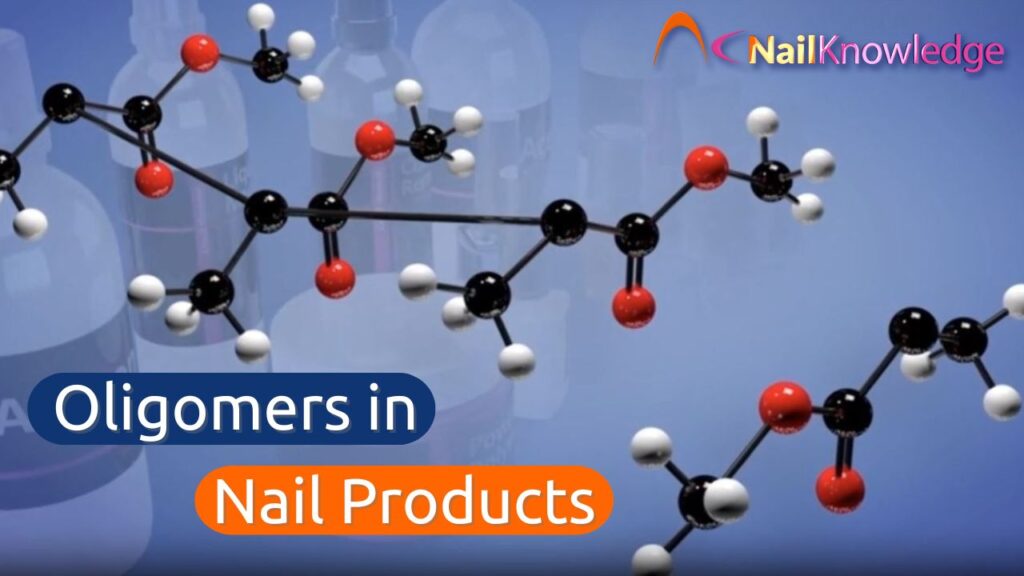Why Oligomers Matter in Modern Nail Chemistry
Oligomers in nail products are a core ingredient in modern gel systems and other UV-cured coatings. These specialised chemical compounds are responsible for many of the qualities nail professionals and clients value, from a smooth application to long-lasting wear. Yet, despite their importance, they are often misunderstood or overlooked in conversations about nail chemistry.
For anyone working with gel polish, builder gels, or other light-cured systems, having a basic knowledge of oligomers can improve product choice, application techniques, and client safety. This knowledge can also help professionals cut through marketing claims and focus on what truly impacts performance.
What Are Oligomers in Nail Products
Oligomers are short chains of molecules that are partly built but not yet fully formed polymers. In other words, they are intermediate structures between liquid monomers and solid polymers. This makes them reactive and ready to link together when exposed to the correct conditions, such as UV or LED light.
In the context of nail chemistry, oligomers are selected for their ability to control how a product behaves before and after curing. They are not just passive ingredients. They directly affect:
- Độ nhớt: how thick or thin the gel feels
- Application control: how easily the product moves and levels on the nail
- Curing quality: how completely the product hardens
- Performance: how strong, flexible, and durable the coating becomes
Functional Role of Oligomers in Gel Coatings and Nail Enhancements
Oligomers in nail products influence almost every stage of the nail service. From the moment the gel is applied to the final cured result, their properties shape the outcome.
Key contributions include:
- Controlling flow: High-viscosity oligomers create thicker builder gels that stay in place, while low-viscosity oligomers produce self-levelling products ideal for smooth overlays.
- Reducing shrinkage: Oligomers minimise the pull-away effect that can lead to lifting.
- Enhancing adhesion: They help form a stronger bond between the coating and the natural nail.
- Determining flexibility: The type of oligomer used can make the cured gel more rigid or more flexible, depending on the desired finish.
- Improving wear: By influencing scratch resistance and gloss retention, they help nails look fresh for longer.
Different Types of Oligomers in Nail Chemistry
Not all oligomers are the same. Manufacturers choose specific types or blends to create unique performance profiles.
Common categories include:
- Urethane acrylates: Known for flexibility and toughness. They help coatings withstand daily wear without cracking.
- Epoxy acrylates: Provide excellent gloss and high chemical resistance, making them ideal for top coats.
- Polyester acrylates: Enhance adhesion and durability while balancing flexibility.
- Custom blends: Many products use a mix of different oligomers to balance application, curing, and wear properties.
Each type of oligomer has a distinct molecular structure that influences the final feel and performance of the cured coating. Product chemists often experiment with these ratios to deliver gels with unique benefits.
How Oligomers React During the UV or LED Curing Process
The curing process transforms the applied gel into a solid, crosslinked coating. Here is what happens:
- Application: The gel, containing oligomers, monomers, and a photoinitiator, is applied to the nail.
- Activation: When exposed to UV or LED light, the photoinitiator absorbs energy and produces reactive species.
- Linking: These reactive species cause the oligomers and monomers to link together in a process called polymerisation.
- Solid network: The short chains of the oligomers join to form a long, crosslinked polymer network.
- Final result: The product becomes hard, durable, and ready for daily wear.
Without oligomers, this reaction would be less controlled, leading to coatings that are brittle, weak, or prone to defects.
Safety Considerations with Oligomers in Nail Products
Oligomers are safe when fully cured, but uncured material can cause skin sensitivity or allergic reactions in some individuals. Nail professionals can reduce the risks by:
- Following the manufacturer’s recommended curing times and lamp specifications
- Avoiding skin contact with uncured product
- Wiping away any spills immediately using an appropriate cleanser
- Maintaining clean tools and work surfaces
- Educating clients not to pick or peel coatings, as this can expose uncured layers
Proper curing is especially important. If the light output, wavelength, or exposure time is incorrect, some oligomers may remain unreacted. This not only affects safety but also reduces the durability of the service.
Why Understanding Oligomers Matters for Nail Professionals
A strong grasp of oligomers in nail products can improve both technical skills and client trust. It enables professionals to:
- Select products based on real performance needs rather than marketing hype
- Troubleshoot issues such as lifting, peeling, or poor gloss retention
- Explain the science behind services to curious clients
- Stay informed about ingredient safety and regulatory updates
- Build a reputation for delivering consistent, high-quality results
Educated nail professionals can also better assess new products. By reading ingredient lists and recognising oligomer types, they can predict how a gel is likely to perform before even opening the bottle.
Key Takeaways on Oligomers
Oligomers are the backbone of many modern nail coatings. They control viscosity, improve adhesion, reduce shrinkage, and determine the flexibility and durability of the cured result. Understanding them is not just for chemists. It is essential for any nail professional who wants to deliver safe, beautiful, and long-lasting nails.
By applying this knowledge, professionals can work more effectively, avoid common issues, and build a stronger connection with clients through transparent, science-based service.


